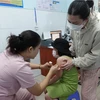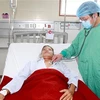Vietnam has an estimated 400,000 blind people, 66.1 percent of whom have cataracts, reported the Vietnam National Institute of Ophthalmology (VNIO) in Hanoi on Oct. 8.
Speaking at a meeting to mark 2009 World Sight Day (WSD), Deputy Health Minister Nguyen Thi Xuyen highlighted the outstanding achievements made by the country’s ophthalmology sector, which she said, has helped many people to access better eye care.
However, Xuyen noted, there is still a high rate of blindness in the country. “Vietnam is committed to supporting the global initiative “Vision 2020” and will earmark funds from its budget to blindness prevention and control until 2020,” said the deputy minister.
According to a survey conducted by the VNIO in 2007, the rate of blindness fell from 0.63 percent in 2000 to 0.59 percent in 2007 and 83 percent of cases could be prevented or treated. In particular, the rate of blindness in people aged over 50 is 3 percent.
To further reduce the blindness rate, the sector will provide surgery to between 170,000-250,000 cataract patients by 2012, introduce a refractive care programme and devise a glaucoma prevention and control project in the community. It will also expand a retinopathy of prematurity (ROP) treatment project and build two refractive errors training centres in Hanoi and Ho Chi Minh City .
In response to the 2009 WSD, the VNIO has provided examinations and medicines to 150 people and conducted free operations on 255 poor cataract patients in the northern provinces of Bac Ninh, Ninh Binh and Bac Giang and Hanoi .
Meanwhile, the HCM City Eye Hospital has provided free check ups to people aged over 70 and 150 female glaucoma patients aged over 55 as well as consultancy services and medicines to 2,000 people.
Also at the meeting, the Vietnam Ophthalmology Association and the VNIO honoured 11 families whose relatives had donated their corneas./.
Speaking at a meeting to mark 2009 World Sight Day (WSD), Deputy Health Minister Nguyen Thi Xuyen highlighted the outstanding achievements made by the country’s ophthalmology sector, which she said, has helped many people to access better eye care.
However, Xuyen noted, there is still a high rate of blindness in the country. “Vietnam is committed to supporting the global initiative “Vision 2020” and will earmark funds from its budget to blindness prevention and control until 2020,” said the deputy minister.
According to a survey conducted by the VNIO in 2007, the rate of blindness fell from 0.63 percent in 2000 to 0.59 percent in 2007 and 83 percent of cases could be prevented or treated. In particular, the rate of blindness in people aged over 50 is 3 percent.
To further reduce the blindness rate, the sector will provide surgery to between 170,000-250,000 cataract patients by 2012, introduce a refractive care programme and devise a glaucoma prevention and control project in the community. It will also expand a retinopathy of prematurity (ROP) treatment project and build two refractive errors training centres in Hanoi and Ho Chi Minh City .
In response to the 2009 WSD, the VNIO has provided examinations and medicines to 150 people and conducted free operations on 255 poor cataract patients in the northern provinces of Bac Ninh, Ninh Binh and Bac Giang and Hanoi .
Meanwhile, the HCM City Eye Hospital has provided free check ups to people aged over 70 and 150 female glaucoma patients aged over 55 as well as consultancy services and medicines to 2,000 people.
Also at the meeting, the Vietnam Ophthalmology Association and the VNIO honoured 11 families whose relatives had donated their corneas./.



















